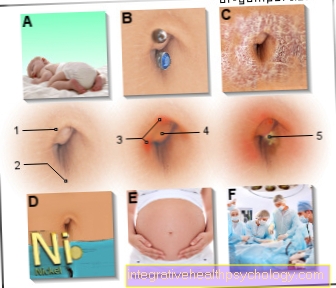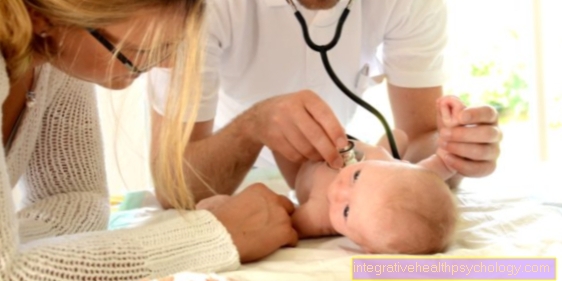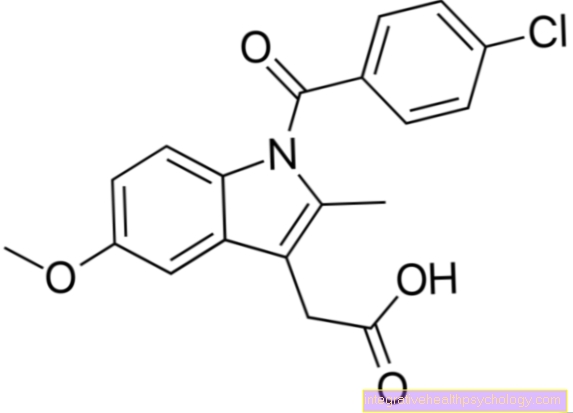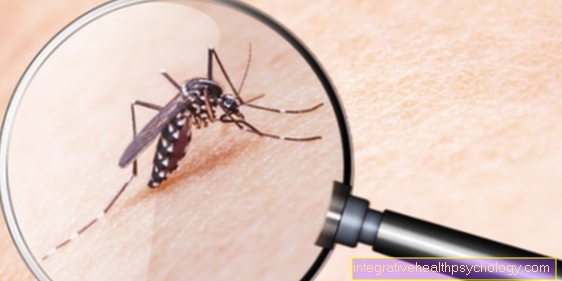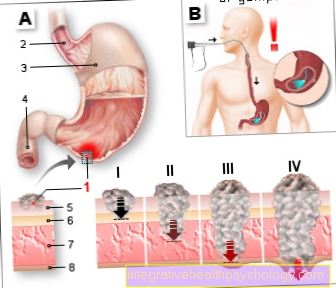Atheroma - You Must Know That!
Definition
An atheroma is a benign skin cyst that forms when the duct of a sebum gland becomes blocked. Hence the atheroma is also called sebum cyst. The term “groats bag” is also popularly used. The cyst is filled with sebum and skin cells. It appears elastic and bulges like a 1 to 2 cm large bump over the skin level. It is often not painful and can appear all over the body. In the center of the swelling, the duct of the blocked sebum gland can often be seen as a black point. The atheroma only needs to be removed if it becomes infected or causes discomfort.

Concomitant symptoms
Atheromas are bulging, elastic bumps that usually do not cause any discomfort. Most of the time, they are primarily perceived as cosmetically disturbing. Sometimes, however, a feeling of tension in the skin can be perceived.
Most atheromas are about 1 to 2 cm in size. In some cases, however, the atheroma becomes the size of a chicken egg. In this case, the skin becomes very tense and stretched. This can cause the hairs on the atheroma to be further apart than on other parts of the body. Sometimes the hair in this area can be completely absent.
An inflamed atheroma is painful. In addition, when it is inflamed, it is no longer skin-colored, but reddened. In addition, it is overheated compared to the rest of the skin.
These are causes of atheromas
When it comes to the causes of atheroma, a distinction must be made between two different types of atheroma.
The so-called “real” atheroma is also called an epidermal cyst and is visually noticeable by a black point in the center of the swelling. This point represents the exit of the blocked duct of a hair. The exit point of the hair is blocked by skin cells in the case of the epidermal cyst. This happens when the skin cells on the scalp multiply too quickly. As a result, skin cells accumulate in the duct of the hair, as these can no longer be released to the surface of the skin as small horny scales. The accumulation of the horn scales results in the visible bump.
If several atheromas appear at the same time, this is often associated with acne. Atheromas can also develop after an injury to the skin.
Also read: Acne - This works best
Atheromas can also be a symptom of the rare Gardner syndrome. This is a hereditary disease that, in addition to epidermal cysts, becomes noticeable through increased polyps in the intestine and benign bone tumors as well as soft tissue tumors.
For more information, see:
- Colon polyps
- Colon polyp symptoms
- Bone tumor
Atheromas are sporadically detected even after treatment with cyclosporine A. Cyclosporin A is a drug that is used, for example, in people who have undergone an organ transplant to reduce the activity of the immune system. However, the cause of the formation of atheromas often remains unexplained.
You might also be interested in: Immunosuppressants
The so-called “false” atheromas or trichilemmal cysts do not have a central duct. They arise from a blockage of the excretory duct of a sebum gland. Every hair has a sebum gland that constantly releases sebum into the protuberance in which the hair is attached. If the duct of the sebum is blocked by skin cells, for example, the sebum builds up and a trichilemmal cyst develops.The trichilemmal cyst is therefore always a little deeper under the skin, as it can never be above the sebum gland. The tendency to develop trichilemmal cysts is occasionally inherited.
Also read:
- Sebum cysts
- Blocked sebum gland - what to do?
Diagnosis of atheromas
A dermatologist can diagnose atheroma. This recognizes the skin cyst by its characteristic appearance and the firm, elastic consistency. In addition, atheromas are usually not painful. The lump does not become painful until there is inflammation.
The distinction between the epidermal cyst and the trichilemmal cyst, both of which are often summarized under the term atheroma, is achieved on the one hand because the epidermal cyst has a central duct that the trichilemal cyst does not have. In addition, the last-mentioned especially on the hairy head, while the epidermal cyst can appear all over the body. They are mainly found on the face, on the back, on the upper arm and thighs and on the scrotum.
What to do if an atheroma has burst
Every now and then it can happen that an atheroma bursts open. It is important to know that bursting does not mean healing of the atheroma. If the pus has evacuated, the wound can be flushed with wound disinfectant and the inflammation can be contained in this way. In any case, however, a doctor should be consulted. This should remove the remains of the atheroma that remained in the skin. When it bursts, part of the atheroma remains. If this is not removed, the atheroma can reappear quickly.
What is an inflamed atheroma?
Inflammation of the atheroma usually occurs when those affected try to pinch or prick the atheroma like a pimple. Through this manipulation, germs get into the atheroma and a bacterial infection can occur. This triggers an inflammatory reaction. The inflammation is noticeable through reddening and overheating of the skin area. In addition, the inflamed atheroma is extremely sensitive to pain. Pressure and touch are associated with pain.
If there is bacterial inflammation, pus may develop inside the atheroma. Under certain circumstances, this can spontaneously empty itself to the surface of the skin. It is important not to try to squeeze out the inflamed atheroma in order to drain the pus, as pushing the pus into deeper layers of the skin can cause the inflammation to spread.
In the case of an inflamed atheroma, particular caution is required on the head, as the inflammation must be prevented from spreading to the brain. Therefore, at any sign of inflammation of the atheroma, a doctor should be consulted!
The doctor can specifically empty the pus cavity without it spreading. It may be necessary to take an antibiotic to fight the bacterial infection. The attending physician can best assess whether this is necessary or not. In addition, in some cases, a drain is placed in the inflamed atheroma. This should make it possible that pus that has not been removed can still drain in the coming days.
Which ointments can help against atheroma?
The basic rule is that no ointments can remove the atheroma. As long as the atheroma is not inflamed, no therapy is required. Only very large or cosmetically disturbing atheromas should be surgically removed.
However, there is one exception, when the atheroma can also be treated with ointments. This represents the inflamed atheroma, which has already formed a pus cavity. This can be treated with pull ointment. However, this ointment does not cause the atheroma to disappear either, but only that the pus focus matures faster and can be opened. It also has anti-inflammatory and analgesic effects.
If the non-inflamed atheroma is treated with pulling ointment, the atheroma can also open up, as the ointment contains substances that soften the skin. The difference to the inflamed atheroma, however, is that the opening does not bring any relief. The accumulated skin flakes and sebum are drained. However, the capsule of the atheroma remains in the skin and therefore atheroma will quickly return to the site.
Read more about: Pull ointment
Pull ointment
Pull ointments are ointments that are usually made from oil shale and contain the active ingredient ammonium bituminosulfonate. They have an antibacterial, anti-inflammatory, circulatory and analgesic effect. In addition, the ointment reduces the flow of sebum and softens the skin, which makes it easier for a pus to empty. The pull ointment is used for foci of pus, such as as part of acne or boils. Even with an inflamed atheroma, the pus cavity can be emptied earlier with the help of the pulling ointment.
You might also be interested in:
- Acne - That Works Best!
- Home Remedies For Acne - That Works Best!
- Acne - cause, symptoms, therapy
- Proper treatment of a boil
- Ointment for a boil
- Boils - Causes, Treatment, Prevention & More
Should I take antibiotics for atheroma?
A bacterially infected atheroma may not be able to be operated on if it is inflamed. In this case, it may be necessary for the doctor to first prescribe a suitable antibiotic. When the inflammation has healed, surgical removal of the atheroma can then be performed. It is important to note that antibiotics only work if the inflammation is due to a bacterial infection. Therefore, an antibiotic is not indicated for every inflamed atheroma.
Read more about: Antibiotics
Can you remove atheromas yourself?
Atheromas should under no circumstances be removed by yourself. On the one hand, the untargeted pressure on the atheroma can lead to an evacuation of the accumulated mass of horny cells and sebum into the lower skin layers. This promotes inflammation and ultimately worsens the course of the disease. The inflammation makes it harder for the dermatologist to remove the atheroma and antibiotics may have to be used.
On the other hand, emptying the atheroma by pricking does not bring long-term success. Even if the atheroma appears smaller after the contents have been emptied, in most cases it will return after a short time. This is because the duct and capsule of the atheroma remain in the skin. Therefore, dander can easily build up again and the atheroma is back.
Read more about: Dander
The conclusion is that an atheroma should always be removed by a doctor, for example a dermatologist, as he or she can remove the atheroma completely, including the capsule and duct, without inflammation, making long-term success more likely.
How is an atheroma removed (OP)?
Small atheromas that do not cause any symptoms do not necessarily have to be surgically removed. However, the larger the atheroma, the more likely it is to have surgery, as this prevents the risk of infection. While the non-irritating atheroma is easy to remove surgically, an inflamed atheroma is somewhat more difficult to operate. The procedure is usually carried out under local anesthesia of the relevant skin area and can be performed on an outpatient basis. If the atheroma is already inflamed, general anesthesia may be necessary. In principle, a lay person should strongly advise against removing the atheroma himself, as the risk of an infection spreading is too high and it cannot be guaranteed that the entire atheroma has been removed.
Also read:
- The risks of general anesthesia
- Side effects of local anesthesia
The goal of atheroma removal is always to remove the atheroma as a whole and completely, as this reduces the risk of the atheroma recurrence. The easiest way to achieve this is to remove the atheroma in its uninjured capsule.
The duct of the hair, which in some atheromas (epidermal cysts) appears as a black point in the center, should also be completely removed so that it cannot become clogged again as it progresses.
An inflamed atheroma cannot simply be completely removed without damaging the capsule. Therefore, in this case the procedure is the same as for the surgical removal of a pus cavity. First the pus focus is opened and all pus and sebum are thoroughly removed. The wound is treated hygienically and rinsed. In addition, the patient receives antibiotic therapy to prevent bacterial infection by spreading the germs from the inflamed atheroma. Afterwards, when the wound is no longer inflamed, it may be necessary to remove the remaining parts of the atheroma in order to prevent the atheroma from recurring.
If the inflammation can still be well controlled, antibiotic therapy can be carried out first and then the operation can be carried out in a second session after the inflammation has subsided.
Duration of an operation
Atheroma removal is a short, simple operation lasting approx. 15 to a maximum of 30 minutes. It is not associated with hospitalization and can also be carried out on an outpatient basis in a dermatologist's practice. Since the operation only requires local anesthesia of the skin in most cases, the patient can quickly be resilient even after the operation.
Also read: Side effects of local anesthesia
Can you treat atheroma non-surgically?
Some people who want to avoid the small operation try to heal the atheroma through homeopathy. Homeopathy is a doctrine that is committed to treating the disease as a whole, rather than specifically treating the disease. It seeks to treat the predisposition that enabled people to develop the particular disease. So it is believed that stress can lead to a tendency to atheroma. Hence, there is also an opinion that effective stress reduction could lead to fewer atheromas.
Also read:
- Symptoms of stress
- Consequences of stress
- How can you reduce stress?
There are also a number of recommended homeopathic remedies for atheromas. The advantages are that these remedies have very little to no side effects. The disadvantage, however, is that the effect has not yet been scientifically proven. Therefore, the profit of treatment with homeopathic remedies is questionable. Whether homeopathic therapy should be attempted depends heavily on the patient's level of suffering and the openness to homeopathy.
Home remedies for atheromas
Home remedies for atheromas can mainly be used when the atheroma has become infected. If there is no inflammation, the home remedies do not bring any benefit, as the atheroma does not go away. However, if there is inflammation, home remedies can relieve pain and reduce inflammation, helping to heal the inflammation.
Tea tree oil is an essential oil that is extracted from the Australian tea tree and has a strong antibacterial effect. With that in mind, it speeds healing and soothes inflammation. However, the tea tree oil should not be used undiluted and should not be used for several weeks at a time, as contact allergies may develop.
Aloe vera gel can also be used. This is attributed to the fact that it stimulates the immune system and should contribute to wound healing or, in this case, to the healing of the inflamed atheroma.
You might also be interested in:
- Which home remedies strengthen the immune system?
- How can you strengthen the immune system?
Chamomile tea bags can also be placed on the atheroma and provide relief.
In general, when it comes to home remedies, the benefit is controversial and you have to try yourself to see if relief occurs. In any case, however, a doctor should be consulted in the event of an inflamed atheroma to clarify whether he should also prescribe an antibiotic. Because the home remedies help calm the inflammation, but the cause is not combated.
Tea tree oil
Tea tree oil is extracted from the Australian tea tree. The ingredient terpene inhibits the growth of bacteria, viruses and fungi. This is why tea tree oil is mainly used in naturopathy for wounds and skin diseases. However, it is not approved as a medicinal product. The possible side effects are very minor, but the tea tree oil should not be drunk under any circumstances and, if possible, not used on irritated, cracked skin, as contact allergies can occur. Due to the mentioned effect against bacteria, the tea tree oil can also be used to treat inflamed atheromas. However, independent treatment with tea tree oil does not replace a visit to the doctor. If the atheroma is not inflamed, tea tree oil does not bring any improvement.
Read more about: Naturopathy
Atheromas in the genital area
Atheromas in the genital area are also harmless and do not necessarily require therapy. However, when atheromas affect the genital area, many people perceive them as more annoying than in other parts of the body. Depending on the situation, sexual intercourse may be restricted. Under certain circumstances, this restriction can simply be based on a high level of shame. Annoying bumps are not readily tolerated in the genital area.
As with the rest of the body, the same applies to the genital area that the atheromas should not be squeezed out! The manipulation allows bacteria to enter the skin and widespread inflammation can occur. Therefore, if the atheroma is bothersome or if it restricts sexual intercourse, a dermatologist should be consulted as early as possible, who can remove the atheroma gently. Again, a non-inflamed atheroma is easier to remove than an inflamed one. But even if there is already an inflammation, you should not be afraid of going to the doctor. Many people are particularly anxious when they have surgery on their genital area. However, this concern is unfounded, as the procedure can be performed just as quickly and easily as on the rest of the body. To avoid large wounds, however, it is advisable to have the atheroma removed as early as possible.
Atheromas on the testicle
Atheromas on the scrotum are called scrotal cysts. Most often there are several atheromas on the scrotum at the same time. They are about 0.5 to 3 cm in size on the testicles and appear bulging and slightly yellowish. Many men first feel the atheroma as a lump in the scrotum tissue. Most of the time the atheromas are not inflamed and therefore painless. Only a slight feeling of pressure and heaviness in the scrotum is often perceived. However, if inflammation occurs, there is a particular risk of the inflammation spreading to the testicles or the seminal ducts on the scrotum. In addition, the pain can radiate to other parts of the body, such as the groin, leg or stomach area, if the atheroma presses on sensitive nerves.
If the atheromas are perceived as bothersome due to their location in the genital area or if there is a painful inflammation, they should be removed by a dermatologist. This removes each atheroma individually along with the respective capsule. It is essential to ensure that the contents are not emptied, otherwise the probability is increased that further atheromas develop.
Atheroma on the forehead
Since the forehead has many sebum glands, atheromas can also appear here more often. Sometimes bumps on the forehead can be caused by a benign overgrowth of fatty tissue called a lipoma. The dermatologist can tell the two bumps apart by their appearance alone.
Since scars on the face are often perceived as particularly annoying, some dermatologists also offer to remove the atheroma on the forehead using a laser or radio waves.
Also read: Lipoma on the face or forehead
Atheroma on the cheek
Atheromas of the cheek are often discovered very early. This is not due to increased symptoms, but simply because the swelling in the face makes it very quickly noticeable for the patient himself and his fellow human beings. Even if atheromas on the face are often perceived as cosmetically annoying, they are mostly harmless. If the atheroma is to be removed, the doctor should make sure to stick to the natural folds of the skin in the direction of the incision in order to guarantee good wound healing and a visually good result.
Atheromas on the ear
On the ear, atheromas usually appear near the back of the earlobe or behind the ear.In this position, the atheroma can be perceived as very annoying, especially for people who wear glasses, since the atheroma causes the temple not to fit perfectly, depending on the position. In addition, inflamed atheromas behind the ear are particularly stressed because the glasses constantly exert pressure on the atheroma, which can be painful. The same applies to people with hearing aids. The hearing aids need to sit snugly behind the ear for them to work properly. An atheroma can prevent this and therefore require the doctor to remove it quickly.
In addition, an atheroma behind the ear can also be perceived as cosmetically disturbing, as the pressure on the ear can cause the ears to protrude a little further from the head.
Atheromas on the earlobe
Atheromas on the earlobe are quickly noticed due to the swelling. You are harmless. However, caution should be exercised if the atheroma becomes inflamed. In this case, in no case should it be expressed, otherwise the inflammation may spread to the neck and head. This can lead to fever and severe pain. Therefore, if the atheroma becomes infected, a dermatologist should be consulted immediately. An inflammation can be recognized by the fact that the atheroma continues to swell, appears red, is overheated and hurts. The dermatologist can completely remove the atheroma and assess whether antibiotics are necessary if the inflammation has already spread.
Atheroma on the chest
The chest is also one of the parts of the body with a particularly large number of sebum glands. Atheroma in the breast area can sometimes be wrongly misinterpreted as a breast tumor, especially by women. The important difference, however, is that the atheroma lies quite superficially under the skin and sometimes has a black point in the middle, while a breast tumor starts out from the mammary gland tissue and is usually deeper in the breast tissue. The exact differentiation can, however, be made with certainty by the dermatologist or gynecologist. Of course, men can also have atheromas in the hairy chest area. The treatment does not differ from that of other parts of the body.
Further information can be found at:
- Recognize breast cancer
- Symptoms of breast cancer
Atheromas in the armpit
Atheromas can also appear in the armpit area. Alternatively, if you have red, painful swellings in the armpits, you should also think of swollen lymph nodes. Acne inversa can also appear similar. Acne inversa is a chronic inflammatory disease of the skin which can lead to abscesses (pus cavities) in the genital area and under the armpits. A dermatologist can differentiate between the various diseases, all of which cause painful bumps under the armpits.
For more information, see:
- Lymph node swelling in the armpit - dangerous?
- Acne inversa - symptoms, therapy, causes
Atheromas on the back
Atheromas on the back are often noticed late because they are only small at first and do not cause any discomfort. They only become painful in the inflamed stage and must then be treated by a doctor.
Sometimes inflamed atheromas on the back can be mistaken for acne. Because they can resemble large cavities of pus.
Which doctor treats atheroma?
The best way to treat atheroma is to see a dermatologist. He or she knows best about all benign and malignant changes in the skin. In addition, the dermatologist may be able to safely cut open the atheroma and remove it completely in his practice.
forecast
The prognosis for atheroma is generally very good. The atheroma can be safely and easily removed by a doctor with no long-term consequences. Surgery for an inflamed atheroma is a little more tedious and the inflammation should not spread. However, the inflamed atheroma can also be treated well with medical help. Sometimes atheromas also disappear on their own. However, it is essential to avoid pushing around on the atheroma, as this can trigger or worsen the inflammation, which leads to a longer healing phase.
What is atheromatosis?
The term atheromatosis is somewhat misleading. It is used not only in the skin area, but also describes the deposition of fats in vessels, accompanied by characteristic changes in the inner wall of the vessels. The atheromatosis is thus a synonym for atherosclerosis. This is a very common disease in older people.
In the skin area, however, atheromatosis is a completely independent disease. It describes the presence of several atheromas (groats) that are not only found in one area of the skin, but increasingly all over the body. Since atheromas can only occur on hairy skin, the soles of the feet and palms are typically never affected.







